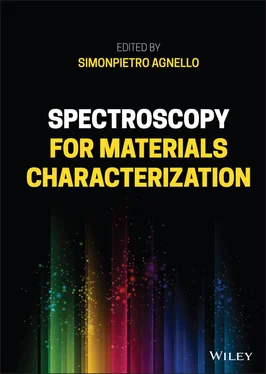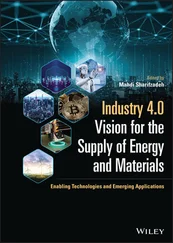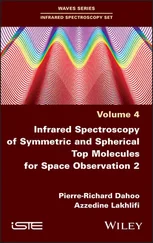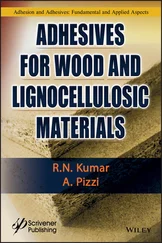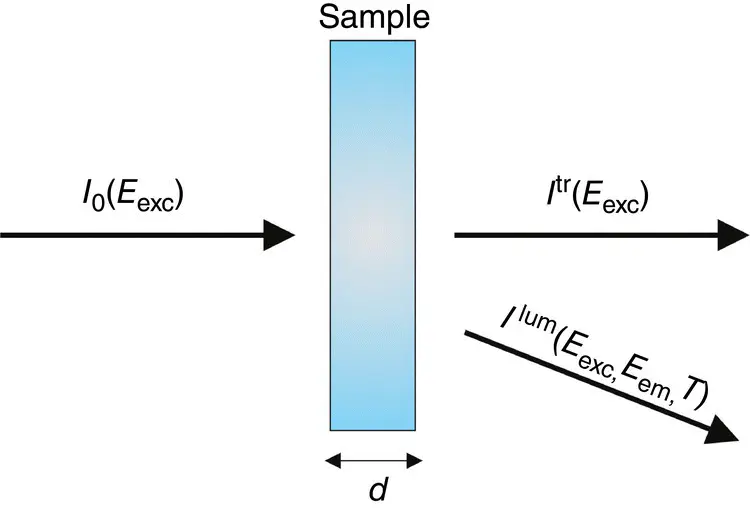
Figure 2.4Scheme describing the absorption and luminescence of a sample of thickness d. I 0is the incident intensity, I tr( E exc) is the transmitted intensity, and I lum( E exc, E em, T ) is the emitted luminescence intensity.
If I 0is the incident intensity, according to the Lambert–Beer law the transmitted intensity, I tr, is given by:
(2.56) 
where α is the absorption coefficient. This macroscopic parameter is proportional to the defect concentration, N 0, and is related to the transition probability between the ground and excited electronic states associated with the single defect, as described in the previous section. Its dependence on excitation energy, α ( E exc), represents the absorption spectrum whose shape is due to homogeneous and inhomogeneous contributions, in agreement with Eq. (2.55).
The intensity absorbed by the sample is the difference between I 0and I tr:
(2.57) 
If the absorption coefficient and the concentration of the absorbing defects are known, the absorption cross section σE exccan be obtained as:
(2.58) 
Another spectroscopic parameter, frequently used to quantify the absorption probability, is the dimensionless oscillator strength f of an electric dipole transition of energy E between the initial, I , and final, II , electronic states:
(2.59) 
where D I → IIis the electric dipole matrix element defined in Eq. (2.12). The linear relation between the maximum value of α ( E exc), α max, and N 0can be expressed by the Smakula's equation that, for a Gaussian bandshape, is:
(2.60) 
where n is the index of refraction of the medium.
Due to the absorption process, ( N 1 E exc) defects will be in the excited state during exposure of the sample to the excitation light, then a portion of them can decay radiatively, with a rate k r, thus originating the photon emission (luminescence) with energy E em≤ E ex, while the remaining excited defects decay non‐radiatively, with a rate k nrthat depends on temperature. The luminescence intensity is given by:
(2.61) 
where I lum( E em) is the emission lineshape determined by homogeneous and inhomogeneous contributions, in agreement with Eq. (2.55).
The variation rate of the excited state population, N 1, depends on the absorption and decay processes, both radiative and non‐radiative, according to the following equation:
(2.62) 
As described in the previous chapter, steady‐state luminescence experiments are performed when the system undergoes a continuous excitation; in this case d N 1 / d t = 0 and combining Eqs. (2.62)and (2.61)we get:
(2.63) 
where k r/( k r+ k nr) = η is the quantum yield that is the ratio between the number of emitted and absorbed photons. From Eq. (2.63), we can define two types of luminescence spectra:
1 The emission spectrum (PL spectrum) in which the intensity is measured as a function of E em for fixed E exc . This type of spectrum measures the shape and intensity of the band emitted by the sample.
2 The excitation spectrum (PLE spectrum) measures the luminescence intensity, monitored at a fixed E em , as a function of E exc and represents the excitation efficiency of the luminescence spectrum.
The time dependence of luminescence spectra is studied by using pulsed excitation. After the excitation of an ensemble of point defects with a light pulse, which produces a population of N 1(0) of the excited state, the light source is switched off ( I 0= 0) and N 1( t ) decays according with:
(2.64) 
where τ = 1/( k r+ k nr). Combining with Eq. (2.61), we obtain the expression of the luminescence time decay:
(2.65) 
Equation (2.65)defines the time‐resolved luminescence, which can be experimentally tested by detecting PL spectra at fixed time delays from the excitation pulse.
The measure of the lifetime at low temperature, at which non‐radiative rates can be neglected, is only dependent on the radiative rate ( τ r= 1/ k r); it allows to determine the oscillator strength by using the following equation, derived from the relation between Einstein's coefficient for spontaneous and stimulated emission:
(2.66) 
2.2.2 Site‐Selective Luminescence
The use of tunable lasers in the time‐resolved luminescence setup is very advantageous to improve the sensitivity in the acquisition of emission spectra. On the other hand, it allows a selective excitation of defects, on which the site‐selective luminescence is based. To provide a theoretical background on this technique, we consider the absorption and luminescence lineshapes discussed in Section 2.1.5accounting for the homogeneous and inhomogeneous parts. In fact, each defect contributes to the absorption through a homogeneous lineshape governed by the coupling between the electronic transition and both the band vibration and the localized modes. Under the hypothesis of linear coupling with a single localized phonon ℏΩ, the homogeneous lineshape is expressed by:
(2.67) 
Читать дальше
